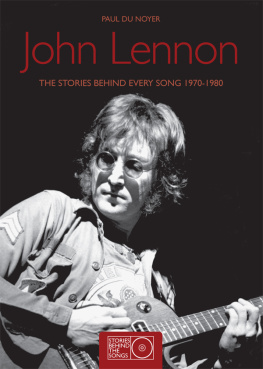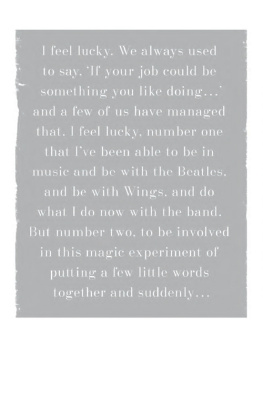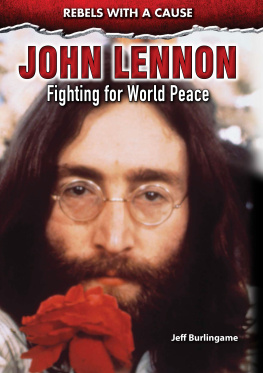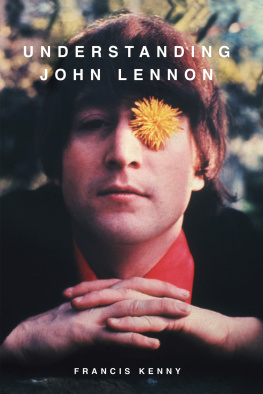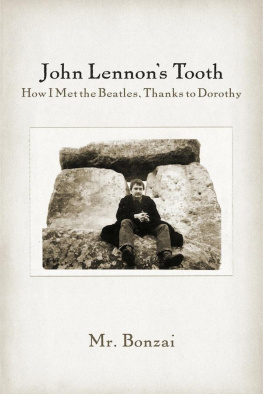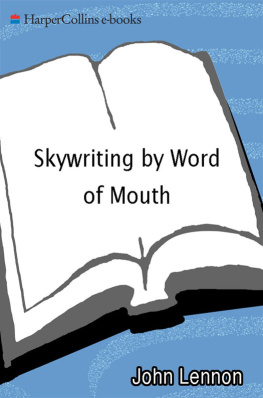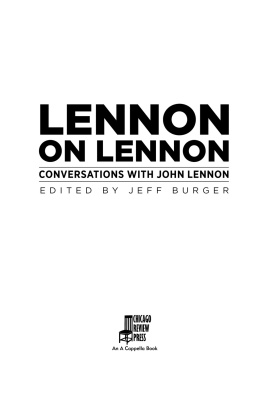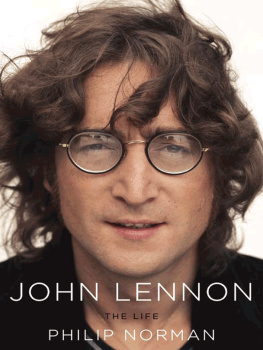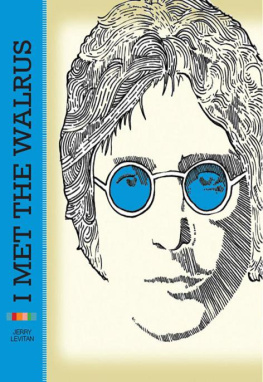THIS IS A CARLTON BOOK
Text copyright Paul Du Noyer 1997, 2000, 2010
Design copyright Carlton Books Limited 1997, 2000, 2010
This revised and updated edition published by
Carlton Books Limited 2010
20 Mortimer Street, London W1T 3JW
This book is sold subject to the condition that it shall not, by way of trade or otherwise, be lent, resold, hired out or otherwise circulated without the publishers prior written consent in any form of cover or binding other than that in which it is published and without a similar condition including this condition, being imposed upon the subsequent purchaser.
All rights reserved.
eISBN 978-1-78011-215-2

CONTENTS
FOREWORD
There is really only one story behind John Lennons songs the story of his life. As a man he was not always honest, but as a songwriter he didnt know how to lie. Lennon tackled his songs like they were episodes of an autobiography. Each of them opens a window on the mans inner self.
There are plenty of books about John Lennons life and the Beatles music. Whats often overlooked, though, is the extraordinary solo work that he produced in his final decade. Even the worthier biographies are light on the details of his music, which is a gap this book attempts to fill. Between the end of the Beatles in 1970 and his murder in 1980, Lennon kept on weaving dreams. To the raging debates of his day, he added the power of his immense celebrity and the force of his sincerity. Now that he has become posteritys favourite pop star, hes remembered as guru, a leader, a preacher. But John was more complex than such pious summaries allow. In his songs he turned that turbulent life into poetry.
Once he was free of the Beatles, Lennons work became unashamedly confessional, and the most enjoyable way to understand his story is through the music. With luck the book that follows might help you enjoy it even more. I write this fourth edition in a room overlooking the River Mersey in Liverpool; from here, millions of Europeans set sail for Johns adopted home, America. Into this port, his Irish ancestors arrived with thousands of others, refugees from hunger. Below my window is Canning Place, where Maggie May plied her trade for the sailors she was the girl he sang of on the last Beatles album, Let It Be, in a folk tune he was re-recording until his final days in the Dakota. Overhead are the aeroplanes descending into what is now called Liverpool John Lennon Airport.
The music is my primary source but there are many others. Especially useful are the lengthy interviews John gave in the last days of his life, promoting his album, Double Fantasy: Andy Peebles conversations for BBC radio, Dave Sholins for RKO, the interviews by David Sheff in Playboy and Barbara Graustark in Newsweek. A US radio series, The Lost Lennon Tapes, made a huge amount of musical material available for the first time. Lennon himself wrote a remarkable memoir, The Ballad Of John And Yoko, compiled in a book of his essays, Skywriting By Word Of Mouth. And Yoko Onos annotations to the 1998 Anthology box are nearly as revealing as the music itself.
There are three major biographies: Albert Goldmans attempted demolition, The Lives Of John Lennon is, if nothing else, horribly readable. Ray Colemans John Lennon is the fans choice, being far superior in accuracy and empathy. The best so far, though, is Philip Normans John Lennon: The Life, for its depth, elegance and insight. Other books I would recommend include The Lennon Companion, edited by Elizabeth Thomson and David Gutman; Jan Wenners Rolling Stone interviews, published as Lennon Remembers; Allen J. Wieners The Beatles: The Ultimate Recording Guide; John Robertsons The Art And Music Of John Lennon; Keith Badmans The Beatles After The Break-Up and Off The Record 2: The Dream Is Over; May Pangs John Lennon: The Lost Weekend, and Come Together: John Lennon In His Time by Jon Wiener.
Ive drawn also on my interviews with people who knew John Lennon personally. My thanks go in particular to Paul McCartney for many hours of conversation on topics including John, to Sean Lennon, Cynthia Lennon, Ringo Starr, Klaus Voormann, Alan White, Bob Gruen, Neil Aspinall, Kieron Spud Murphy, Tony Bramwell, Bill Harry, Billy Preston, Derek Taylor, George Martin, Denis ODell, Andrew Loog Oldham, Pete Best, David Bowie, Tony Barrow, Mike McCartney and Larry Parnes. Special thanks, also, to Yoko Ono, who was complimentary about previous editions of this book. I was always an impartial Beatles fan when it came to Lennon versus McCartney. I might be one of the few people who gets Christmas cards from both Paul and Yoko.
Several friends and colleagues assisted me. I thank Steve Turner (whose Beatle book A Hard Days Write, was the template for this one), Philip Norman, Murray Chalmers, Barry Miles, Mark Ellen, Ronnie Hughes, Robert Sandall, Spencer Leigh, Colin Shearman, Geoff Baker, Mark Lewisohn, Ian MacDonald, Mat Snow, Charles Shaar Murray, Ian Cranna, David Buckley, my agent Ros Edwards and my wife Una. To adapt a line from John Lennons masterpiece of democratic mysticism, may you all shine on.
Paul du Noyer, www.pauldunoyer.com

SHINING ON
His name has come to symbolize our yearning for peace, but John Lennon was born and died in violence. He came into the world on 9 October 1940, when Liverpool was being bombed to rubble by Hitlers air force. The Oxford Street Maternity Hospital stood on a hill above the city centre; below it were the docks that had made the seaport great, but were now earning it a terrible punishment. On many nights the River Mersey resembled Pearl Harbor in those war years, and thousands perished in terrace slums or makeshift shelters. But Julia Lennons war baby survived, and she took it home unharmed. All around them was the din of sirens and explosions.
The Lennons house was small, in a working class street off Penny Lane; Johns father, Freddie, was away at sea. Liverpool was where generations of new Americans took their leave of Europe, and its maritime links with New York stayed strong. Freddie Lennon was like many Liverpudlian men, who knew the bars of Brooklyn better than the palaces of London. Seamen and GIs became a source of the US records that made Liverpool a rocknroll town. Black American music found a ready market in this port, which had grown rich by selling the slaves of Africa to the masters of the New World. In a park near Johns home stood a statue of Christopher Columbus, inscribed: The discoverer of America was the maker of Liverpool.
John was of the usual local stock, not so much English as Welsh and Irish. The latter, especially, had dominated Liverpool since the mass migrations of the famine years. They gave the Lancashire town a hybrid accent all of its own, which John never lost. The Celtic stereotypes were always applied to Liverpool violent and sentimental, lovers of music and words, witty and democratic. Far from breaking the mould, Lennon was that stereotype made flesh.
But his upbringing was traditionally British. His respectable Aunt Mimi looked after John from the age of five. With her husband George Smith she raised the boy in a neat, semi-detached house in Menlove Avenue, on Liverpools outskirts. Post-war Britain was still subject to scarcity and rationing (G is for orange, went Johns poem Alphabet, which we love to eat when we can get them), but his circumstances were comfortable. He had a loving home, and was educated at Quarry Bank, one of the citys better state schools. His background was not as deprived as he sometimes implied.
Next page
